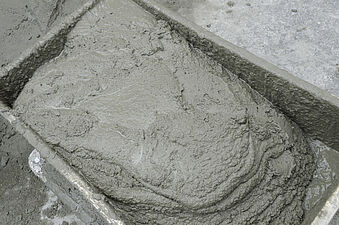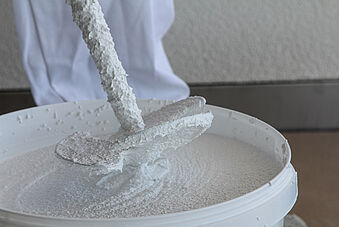The screw pump: Function, areas of application and special features
The screw pump is the powerhouse for highly viscous materials with heavy filling, coarse grain or even fibres – spraying plaster is no problem at all. At the same time, it is also one of the most robust pumps with conceivably simple operation. Read here about the function of the screw pump, its design, areas of application and which WAGNER units are equipped with a screw pump.
The eccentric screw pump: Design and function
“Screw pump” is short for eccentric screw pump. After the inventor, it is also known as the Netzsch pump , or from English as the PCP pump (progressive or progressing cavity pump). It is one of the rotating positive displacement pumps. The pumped medium is transported from the upper tank through the hose to the spray lance.
The eccentric screw pump has two main components: on the one hand the rotor, a rotating screw, and on the other hand the stator, a cylinder in which the rotor is located.
The stator has a similar internal geometry to the rotor ,both are helical. When the rotor rotates in the stator, defined empty spaces (conveying chambers) with circumferential sealing result, thus creating a negative pressure. This in turn ensures that the eccentric screw pump is self-priming. Due to the constant movement of the rotor (in contrast to changes in direction of reciprocating pistons and thus corresponding dead centres), material conveying is low in pulsation. At the injection lance, the medium is then divided with the aid of compressed air and can be applied evenly.
Valves for limiting the delivery spaces do not exist in this pump, which means less wear. The rotor moves eccentrically, which means that the axis of rotation of the rotor does not correspond to the axis of symmetry of the complete pump. This is also where the name of the eccentric wrom pump comes from. The eccentric screw pump should not be confused with the Archimedes screw, which is also called a screw pump and is used today especially in the conveyance of solids such as bulk materials. This is a huge helix that simply pushes the conveying elements (often solids) upwards in a trough. There is no stator in which negative pressure is generated, so that this type of material conveying does not belong to the pumps, but is a constant pressure hoist. It was originally used as a water lifting device in ancient times to pump water.
What is special about the PMV screw pump?
Due to the rotor-stator principle, the WAGNER screw pumps are very easy to operate and infinitely variable and are also suitable for beginners in the field of machine processing. We also make a point of ensuring that our machines are as trouble-free and easy to use as possible for your users – accordingly, PMV mortar spraying equipment can be dismantled and reassembledin just a few steps, even on theconstruction site itself. All the wetted parts are made from stainless steel. In addition, our PlastCoat and PlastMax units have a long service life. They are very robust and particularly low-wear and low-maintenance, and the uncomplicated operation avoids sources of error and thus potential for damage. Our PMV screw pump also works much more quietly than the standard piston pump!


Advantages of the screw pump
The screw pump combines many advantageous features of other pump solutions: Like the centrifugal pump, for example, it has no pressure or suction valves, and like a piston pump, the eccentric screw pump also has excellent pumping speed. The flow rate is constant and speed-dependent.Like a gear or screw pump, it handles pumped material with high viscosity, grain size,fibres and inhomogeneous or abrasive materials.
Spraying particularly heavy materials such as plaster or filler is hard work. The biggest advantage of a screw pump is the possibility of achieving a high working speed and yet a high-quality surface result with little physical effort due to the machine processing . The quality of your work does not decrease, on the contrary, and in addition you can plaster, fill, coat or reinforce surfaces much faster. The more surface area involved, the more obvious the time and material savings.
Which materials can be processed with a screw pump?
Basically, the robust screw pump is suitable for inhomogeneous and abrasive materials without any problems, even a highly viscous material with coarse grains and fibres can be sprayed. However, make sure that the material is labelled as machine-processable by the manufacturer!
A screw pump can process this:
- Plaster
- Mortar
- adhesive and bituminous coatings.
- Flame retardants
- Corrosion protection
- Spray plaster
- ETICS adhesive (External Thermal Insulation Composite System) and others.


Which users and which applications is the screw pump suitable for?
The screw pump is particularly recommended for craft and painting businesses that workoften and frequently with highly viscous substances. For those who regularly plaster, reinforce, fill, coat, pour, grout or backfill large areas, a mortar spraying machine offers an unbeatable advantage in terms of saving a lot of time, material and body strength. Compared to manual application, machine application is less strenuous, easier on the back and the bags or buckets have to be carried much less distance thanks to a maximum delivery height of 20 metres and a delivery radius of 40 metres. This is particularly noticeable in new multi-storey buildings or buildings that are being renovated.
Particularly in basements, industrial buildings or car parks, which consist of few but enormously large surfaces to be coated, a plaster spraying unit such as the WAGNER units with screw pump quickly pays for itself: One person sprays plaster and a second smooths it directly.
People Also Ask
Send Your Enquiry :

